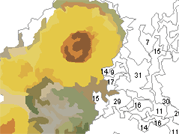
« PREVIOUS ENTRY
Inadvertent mashups
NEXT ENTRY »
A picture’s worth a thousand lies

When I recently read William Bird’s superb book Paint By Number: The How-to Craze that Swept the Nation, I learned how controversial the hobby was. Introduced in 1951, the fad instantly exploded, and one company alone sold 12 million kits in three years. Indeed, the trend grew so rapidly partly because of America’s increasing post-war leisure: The country was so wildly productive that salarymen suddenly had more free time than ever before, and the deportment of spare time became one of the burning questions of the day. But pretty soon, the pseuds were decrying paint-by-numbers as yet more evidence of the decline of American civilization. All those obedient grey-suited hordes, numbly filling in the blanks, working by rote instead of being creative! Writers sent incensed letters into art magazines bemoaning the “morons” who bought paint-by-number kits. Within a few years, paint by numbers had declined into joke status, “by the numbers” had become the supremest of all insults, and in an award-winning image for the cover of Esquire, Richard Hess illustrated Lyndon Johnson as an incomplete picture.
Yet despite the cultural war, paint-by-numbers never died, because of one central fact: They’re fun. And as the two-decade-long family-values moral assault against video games has proven, no matter how hard you try to make people feel like mindless drones, if there’s something they really enjoy doing … you just can’t stop ‘em. Given my own frequently hyper energy levels — and my occasionally ADDish attention span — I’ve wondered whether I might actually find it zenly calming to spend an evening painting some dogs playing poker.
Which is why I was pleased to discover the next best thing: Segmentation, an online java-based application that lets you do hundreds of different paint-by-numbers on your computer. That picture above is a detail of Monet’s Sunflowers, with me halfway through. Computer-based paint-by-numbering isn’t as physically satisfying as the real thing, mostly because it’s pretty brutal on your wrist. But as with the original hobby, part of the pleasure is discovering how a few simple shades produce an amazingly complex image. It’s oddly similar to when I was kid and pressed my nose against the arcade-game screen so I could figure out how many pixels it took to make Mario.
Indeed, the Segmentation folks have closed the loop on the game/painting connection, because they’ve produced a time-trial version of the software: On “expert” level, a countdown clock challenges you to finish the artwork in a few minutes. Intentionally or not, it’s a lovely gloss on that age-old debate about the hobby: By turning artwork into a mechanized twitch game, it fulfils the glummest prophecies of those post-war aesthetes. Yet damn, it’s pretty fun too.
I'm Clive Thompson, the author of Smarter Than You Think: How Technology is Changing Our Minds for the Better (Penguin Press). You can order the book now at Amazon, Barnes and Noble, Powells, Indiebound, or through your local bookstore! I'm also a contributing writer for the New York Times Magazine and a columnist for Wired magazine. Email is here or ping me via the antiquated form of AOL IM (pomeranian99).

ECHO
Erik Weissengruber
Vespaboy
Terri Senft
Tom Igoe
El Rey Del Art
Morgan Noel
Maura Johnston
Cori Eckert
Heather Gold
Andrew Hearst
Chris Allbritton
Bret Dawson
Michele Tepper
Sharyn November
Gail Jaitin
Barnaby Marshall
Frankly, I'd Rather Not
The Shifted Librarian
Ryan Bigge
Nick Denton
Howard Sherman's Nuggets
Serial Deviant
Ellen McDermott
Jeff Liu
Marc Kelsey
Chris Shieh
Iron Monkey
Diversions
Rob Toole
Donut Rock City
Ross Judson
Idle Words
J-Walk Blog
The Antic Muse
Tribblescape
Little Things
Jeff Heer
Abstract Dynamics
Snark Market
Plastic Bag
Sensory Impact
Incoming Signals
MemeFirst
MemoryCard
Majikthise
Ludonauts
Boing Boing
Slashdot
Atrios
Smart Mobs
Plastic
Ludology.org
The Feature
Gizmodo
game girl
Mindjack
Techdirt Wireless News
Corante Gaming blog
Corante Social Software blog
ECHO
SciTech Daily
Arts and Letters Daily
Textually.org
BlogPulse
Robots.net
Alan Reiter's Wireless Data Weblog
Brad DeLong
Viral Marketing Blog
Gameblogs
Slashdot Games